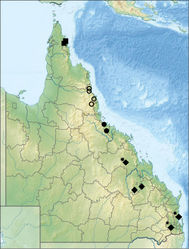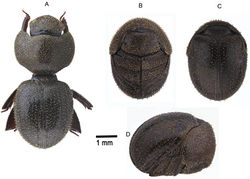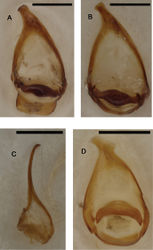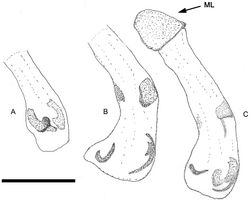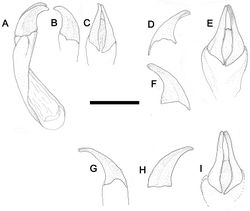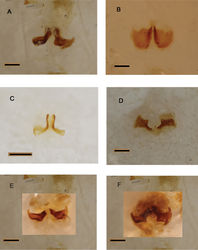Pterorthochaetes danielsi
| Notice: | This page is derived from the original publication listed below, whose author(s) should always be credited. Further contributors may edit and improve the content of this page and, consequently, need to be credited as well (see page history). Any assessment of factual correctness requires a careful review of the original article as well as of subsequent contributions.
If you are uncertain whether your planned contribution is correct or not, we suggest that you use the associated discussion page instead of editing the page directly. This page should be cited as follows (rationale):
Citation formats to copy and paste
BibTeX: @article{Ballerio2013ZooKeys339, RIS/ Endnote: TY - JOUR Wikipedia/ Citizendium: <ref name="Ballerio2013ZooKeys339">{{Citation See also the citation download page at the journal. |
Ordo: Coleoptera
Familia: Hybosoridae
Genus: Pterorthochaetes
Name
Pterorthochaetes danielsi Ballerio, 2013 sp. n. – Wikispecies link – ZooBank link – Pensoft Profile
Type locality
West Claudie River, Iron Range, Queensland, Australia.
Type material
Holotype, male (QM, accession number: T189544): Australia: Queensland: NE: West Claudie R., Iron Range, 3 Dec. 1985, G. Monteith / QM Berlesate no. 690 12.45S, 143.14E Rainanteriorst 50m Stick brushing. [extended specimen, glued on a card, dissected, genitalia mounted in DMHF resin on a separate card, same pin]. Allotype: 1 female [dissected], Iron Range, Cape York Pen., N. Qld. 28 Apr.–5 May 1968. G. Monteith (QM, accession number: T189548). Paratypes [all dissected]: 1 male, same data as holotype (ABCB); 1 male, West Claudie R., Iron Range, N. Qld., 3–10 Dec. 1985, G. Monteith & D. Cook, Pyrethrum knockdown/RF (QM, accession number: T189551); 1 male, Iron Range, Cape York Pen., N. Qld. 5–10 May 1968. G. Monteith (MNHN); 2 males, Iron Range, Cape York Pen., N. Qld. 28 Apr.–5 May 1968. G. Monteith (QM, accession numbers: T189555 and T189556); 1 female, QLD:12.714°S, 143.287°E, East Claudie River, 15 m, 9 Dec 2010 34778, G. Monteith, Bark spray (QM, accession number: T189773).
Description
HL = 0.75 mm; HW = 1.60 mm; PL = 1.75 mm; PW = 2.55 mm; EL = 3.00 mm; EW = 2.60 mm. Overall morphology as in generic description. Dark brown, shiny, setation yellowish, sternum, tarsi and antennae reddish-brown.
Head: completely and uniformly covered by impressed coarse horseshoe-shaped punctures, anastomosing on disc. Anterior portion of clypeus with irregular transverse anastomosing lines. Interocular distance about 11 times maximum width of dorsal ocular area.
Pronotum: margins completely bordered, lateral margins with a row of erect thick yellowish simple setae, about as long as the distance between them. Pronotal setation made of thick medium sized clavate yellowish setae, punctation as follows: disc covered by impressed transverse small horseshoe-shaped punctures, with posterior openings and containing a small fine setigerous pore, sides of disc with a few large ocellate punctures and sides of pronotum with larger horseshoe-shaped punctures with opening laterad. Anterior angles having six longitudinal irregular lines. Distance between punctures distinctly less than their diameter.
Scutellum: basally with two longitudinal irregular rows of horseshoe-shaped punctures, uniting towards apex.
Elytra: humeral callus poorly pronounced, sutural stria occupying the medial and distal third. Elytral punctation as follows: uniformly covered by large horseshoe-shaped punctures, some punctures becoming ocellate at apical third and at sides of elytra. Each horseshoe-shaped and ocellate puncture enclosing a small fine simple puncture bearing a clavate yellowish seta. Interpunctural distance on elytra distinctly less than puncture diameter.
Aedeagus: basal piece about twice length of parameres. Parameres slightly asymmetrical, internal sac distally with some irregular weak sclerotisations (Fig. 13D–F, Fig. 12C).
Male genital segment: as in Fig. 11B.
Bursal sclerites: slightly asymmetrical, as in Fig. 14D, subject to some variability.
Diagnosis
Very close to the New Guinean Pterorthochaetes brevis (Sharp, 1875), from which differs mainly by the punctation of pronotal disc, which in Pterorthochaetes brevis is sparser and of elytra, which in Pterorthochaetes brevis is shallower and sparser. Among the other Australian species it can be easily distinguished by having the elytral punctation in the form of dense, large horseshoe-shaped punctures, almost without isolated simple punctures. The shape of the bursal sclerites, while very similar to those of Pterorthochaetes brevis, is unique within the Australian Pterorthochaetes.
Etymology
Noun in the genitive case. Dedicated to Gregory Daniels, former collections manager at University of Queensland Insect Collection, Brisbane.
Distribution and habitat
Known from the Cape York Peninsula only (Northern Queensland), where it occurs in the lowland rainforests of Iron Range.
Original Description
- Ballerio, A; 2013: Revision of the Australian Ceratocanthinae (Coleoptera, Scarabaeoidea, Hybosoridae) ZooKeys, 339: 67-91. doi
Images
|
